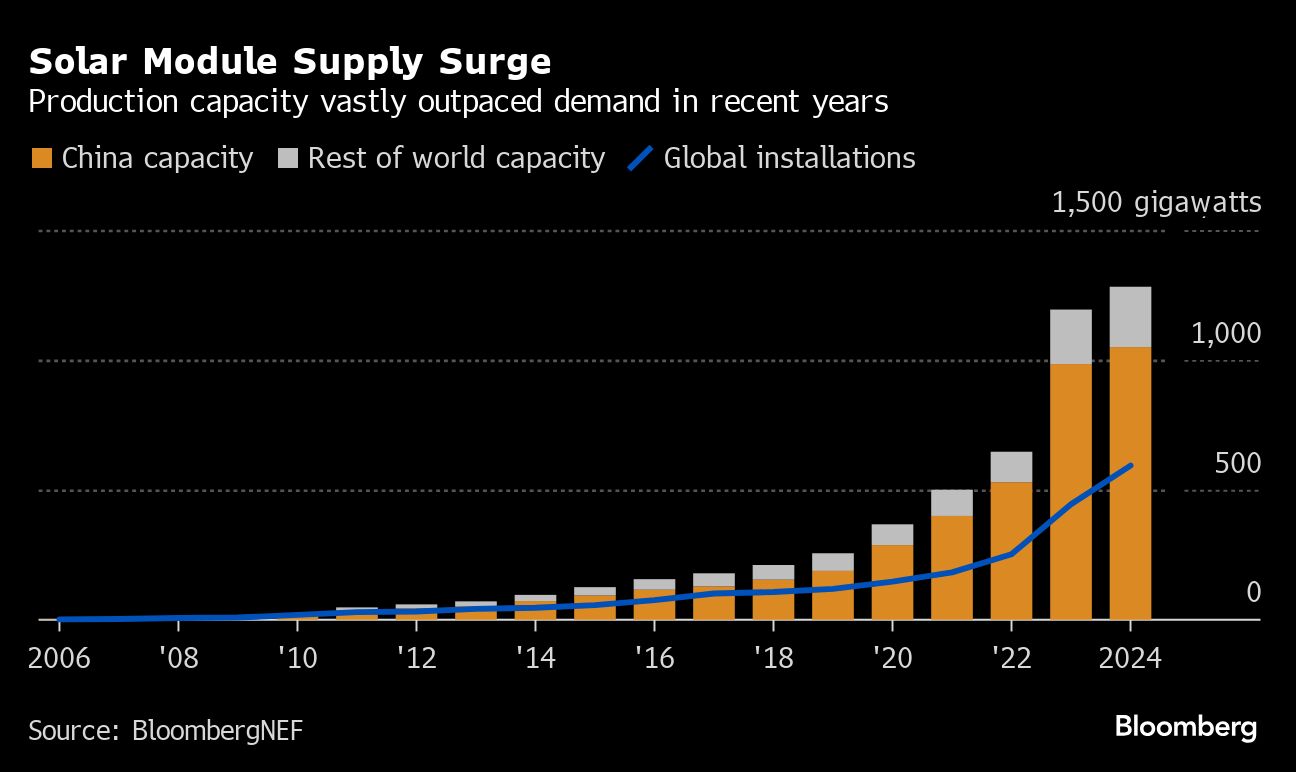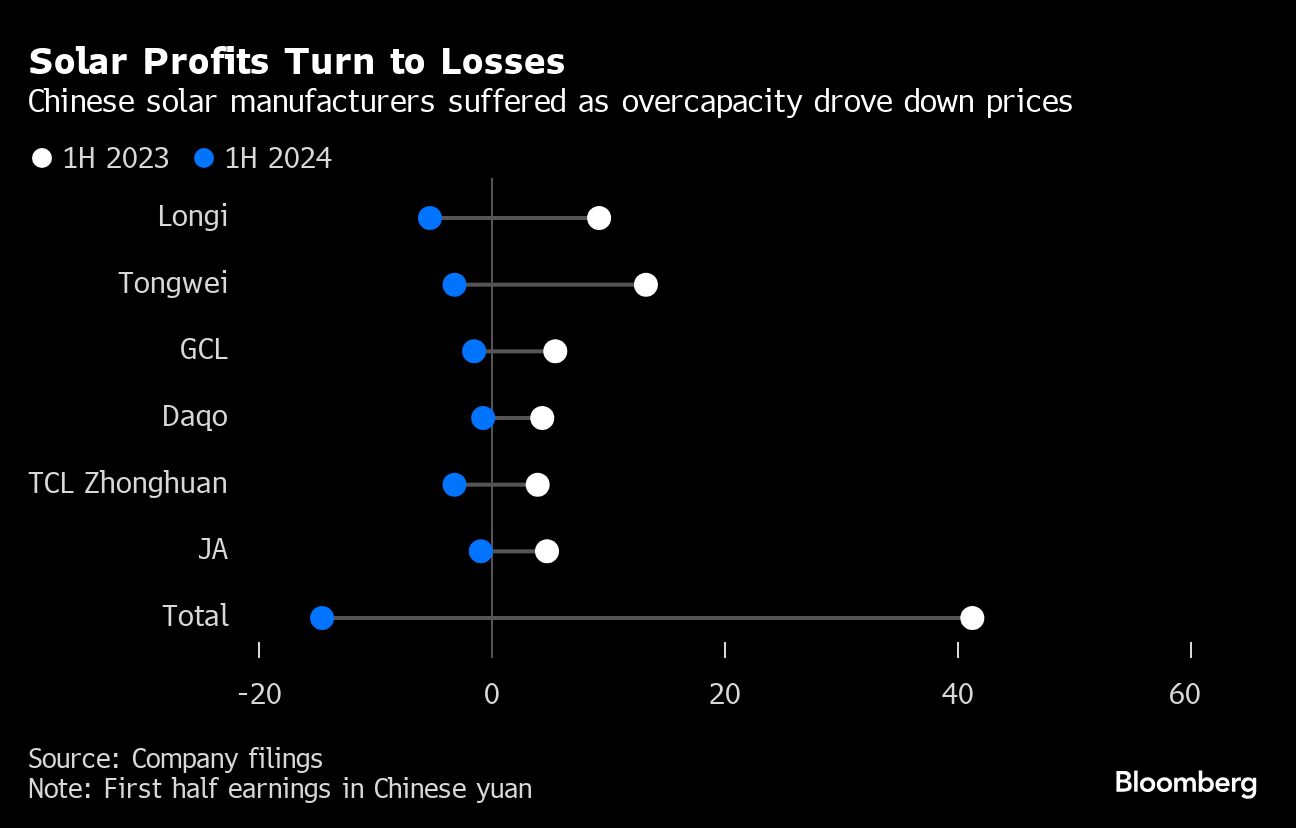
(Aug 31): China’s solar manufacturers have just been through a bloodbath of an earnings season, but there are tentative signs the massive glut that’s plaguing the industry could be starting to ease.
Longi Green Energy Technology Co and five other leading solar firms racked up a combined US$2 billion (RM8.64 billion) of losses in the first half after a frenzy of factory building over the last few years created excess capacity that’s driven prices to record lows. Some smaller companies have already been forced into restructuring, while rising trade tensions with the US and Europe may put exports at risk.
The financial pain looks to be planting the seeds for a turnaround, although a meaningful rebound is unlikely until next year. Goldman Sachs Group Inc sees an imminent wave of factory closures that would help rebalance the market, while Morgan Stanley reckons equipment prices have already bottomed out.
Longi said it hopes to “push the industry out of a quagmire of low price competition” as it raised solar wafer prices this week. TCL Zhonghuan Renewable Energy Technology Co also said this week it will increase prices of three types of wafers, according to a report in Chinese media.
“I don’t know if prices can fall beyond this point. It’s just too much for even the biggest players,” said Cosimo Ries, an analyst at Trivium China in Shanghai. “It’s still going to be a pretty painful year, and maybe longer before that capacity gets cleared.”
The Chinese solar industry’s predicament can be traced back three years ago, when a surge in demand for panels boosted prices and unlocked ambitious expansion plans that resulted in far too much supply.
The sector ended 2023 with the ability to produce 1,154 gigawatts of solar modules — more than double the capacity from two years earlier. Projected demand this year is just 593 gigawatts, according to BloombergNEF.
The health of the Chinese solar industry, which accounts for around 80% of global production, is critical to the fight against climate change. Its travails highlight how hard it is to match production and demand in the many fast-growing sectors tied to the energy transition.
The growing US-China rivalry is also making life more difficult for Chinese manufacturers. Washington is planning to double import tariffs on the country’s solar equipment to 50%, and is also going after Chinese companies that have set up factories in Southeast Asia.
Trade relations between Beijing and the European Union (EU), a major market for Chinese solar equipment, are also deteriorating. A growing tussle over subsidies has spurred a tit-for-tat dispute that started with electric vehicles, and has since spread to pork, dairy and brandy.
“Chinese manufacturers are responding to poor profitability and uncertainties around limitations to market access to the US and EU,” Goldman analysts including Trina Chen said in a note this month. “The China solar industry is heading into the final stage of a downcycle, with a cyclical bottom likely in 2025.”
Longi’s earnings suffered the most, as its net losses amounted to 5.20 billion yuan (US$740 million or RM3.17 billion) over the first six months of the year after earning profits of 9.3 billion in the same period in 2023. Tongwei Co and TCL Zhonghuan Renewable Energy Technology Co each posted losses of more than three billion yuan. JA Solar Technology Co, Xinjiang Daqo New Energy Co and GCL Technology Holdings Ltd were also in the red for the period.
“Facing the rapid expansion of industry production capacity in the past two years and the complex global trade environment, the industry has entered a period of deep adjustment,” Longi said in its earnings filing.
Several executives at top Chinese firms have resorted to asking the central government to intervene to help the industry get back on its feet. The menu of options presented included regulating which new factories can be built, cracking down on less-efficient facilities, capping price cuts, and promoting consolidation.
Some of those actions are already taking place. Tongwei earlier this month bought Jiangsu Runergy New Energy Technology Co in the industry’s first major consolidation move during this downcycle, and expansion plans at several other firms have been delayed or cancelled.
Still, it will likely take another six to 12 months for prices to rise back to break-even levels for solar firms, Morgan Stanley analysts including Eva Hou said in a note.
“The industry will need to either further squeeze production costs or take capacity consolidation up a notch to bring supply-chain prices back to a sustainable level,” she said.
Uploaded by Tham Yek Lee


